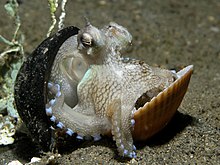Amphioctopus marginatus
| Amphioctopus marginatus | |
|---|---|

| |
| Scientific classification | |
| Domain: | Eukaryota |
| Kingdom: | Animalia |
| Phylum: | Mollusca |
| Class: | Cephalopoda |
| Order: | Octopoda |
| Family: | Octopodidae |
| Genus: | Amphioctopus |
| Species: | A. marginatus
|
| Binomial name | |
| Amphioctopus marginatus (Iw. Taki, 1964)
| |
| Synonyms | |
| |
Amphioctopus marginatus, also known as the coconut octopus and veined octopus, is a medium-sized cephalopod belonging to the genus Amphioctopus. It is found in tropical waters of the western Pacific Ocean. It commonly preys upon shrimp, crabs, and clams, and displays unusual behavior including bipedal and quadrupedal walking as well as tool use (gathering coconut shells and seashells and using these for shelter).
Taxonomy
[edit]Amphioctopus marginatus is a species of octopus located in the family Octopodidae, genus Amphioctopus. The species was first described in 1964 by Japanese malacologist Iwao Taki as Octopus marginatus, and synonymously as Amphioctopus marginatus. In 1976, Z. Dong named the species Octopus striolatus but this name was not recognized as taxonomically valid.[2][3]
Size and description
[edit]The main body of the octopus is normally 8 centimeters (3 in) long and including the arms, approximately 15 centimeters (6 in) long. The octopus displays a typical color pattern with dark ramified lines similar to veins, usually with a yellow siphon. The arms are usually dark in color, with contrasting white suckers. In many color displays, a lighter trapezoidal area can be seen immediately below the eye.
Behavior and habits
[edit]
The species preys predominately on Calappa crabs and bivalves. Eggs are laid in clutches of 100,000 and are 3 millimetres (0.12 in) in length.[2]
Locomotion
[edit]In March 2005, researchers at the University of California, Berkeley, published an article in Science in which A. marginatus was reported to show bipedal locomotion, or "stilt-walking".[4] This involves rolling two legs to walk while the other six legs are used to mimic the appearance of a floating coconut. This behavior was first observed off the coast of Sulawesi, Indonesia, where coconut shell litter is common. A. marginatus is one of only two octopus species known to display such behavior, the other species being Abdopus aculeatus.[5][6]
Tool use
[edit]In 2009, researchers from the Melbourne Museum in Australia observed the coconut octopus uses tools for concealment and defense by gathering available debris to create a shelter. The researchers filmed the octopus collecting coconut half-shells from the sea floor that had been discarded by humans. They were then carried up to 20 meters (66 ft) and arranged around the body of the octopus to form a spherical hiding place similar to a clam-shell.[4][7] This behavior was observed in specimen in Bali and North Sulawesi, Indonesia, and is likely the first evidence of tool use in invertebrates. Other species of octopus had been observed using shells for hiding, but this was the first case in which shells were prepared and collected for later use, in what the Melbourne Museum has described as "true tool use".[8][4][9] Octopuses will often engage in bipedal motion when carrying stacks of debris or items larger than themselves.[4]
Distribution
[edit]The coconut octopus is broadly endemic to neritic, tropical waters in the Indian Ocean, Red Sea, Northwest and Western Pacific Ocean, and Southeast Asian Sea. Amphioctopus marginatus is listed as Least Concern on the ICUN's Red List. While the species may be threatened by fishing, its wide distribution is seen as enough to compensate against human impacts.[2]
Habitat
[edit]The species prefers shallow, subtidal waters along the continental shelf. The species has a maximum depth of 190 metres (620 ft), and can often be found in mud and sand substrates.[2]
References
[edit]- ^ Allen, G & Allcock, L (2018). "Amphioctopus marginatus". IUCN Red List of Threatened Species. 2018: e.T163176A980445. doi:10.2305/IUCN.UK.2018-2.RLTS.T163176A980445.en. Retrieved 7 March 2023.
{{cite journal}}: CS1 maint: multiple names: authors list (link) - ^ a b c d "Amphioctopus marginatus". iucnredlist.org. IUCN Red List. 2014.
- ^ "WoRMS - World Register of Marine Species - Amphioctopus marginatus (Taki, 1964)". www.marinespecies.org. Retrieved 2023-12-28.
- ^ a b c d Gelineau, Kristen (2009-12-15). "Aussie scientists find coconut-carrying octopus". The Associated Press. Archived from the original on December 18, 2009. Retrieved 2009-12-15.
- ^ Sanders, Robert: Octopuses occasionally stroll around on two arms, UC Berkeley biologists report, University of California, Berkeley, March 24, 2005.
- ^ Christine L. Huffard, Farnis Boneka, Robert J. Full: Underwater Bipedal Locomotion by Octopuses in Disguise, Science, March 25, 2005.
- ^ Henderson, Mark (2009-12-15). "Indonesia's veined octopus 'stilt walks' to collect coconut shells". Times Online. Archived from the original on August 15, 2011.
- ^ Finn, Julian K.; Tregenza, Tom; Norman, Mark D. (2009), "Defensive tool use in a coconut-carrying octopus", Curr. Biol., 19 (23): R1069–R1070, Bibcode:2009CBio...19R1069F, doi:10.1016/j.cub.2009.10.052, PMID 20064403, S2CID 26835945.
- ^ Harmon, Katherine (2009-12-14). "A tool-wielding octopus? This invertebrate builds armor from coconut halves". Scientific American. Archived from the original on 2009-12-17. Retrieved 2009-12-15.
External links
[edit]- "CephBase: Amphioctopus marginatus". Archived from the original on 2005-08-17.
- Octopus uses coconuts - Video via EducatedEarth
- Octopus marginatus at National Center for Biotechnology Information (NCBI)
- News
- BBC article with video
- Guardian article with video
- Video using 2 sea shells as a defense shelter
- Photos of Amphioctopus marginatus on Sealife Collection

